Impact of Electric Vehicle on Residential Power Distribution Considering Energy Management Strategy and Stochastic Monte Carlo Algorithm
Abstract
1. Introduction
2. The Proposed System and Input Modeling Data
2.1. Climatology Input Data
2.2. Energy Storage Battery
2.3. Converter
2.4. Residential Charge Facility
2.5. Utility Grid
3. Energy Management Strategy
- Mode 1: Exploiting the RESs (PV and WT) to charge the EV and home appliances.
- Mode 2: Exploiting the BT (LiFePO4) to charge the EV and home appliance.
- Mode 3: Exploiting the utility grid to form (G2V).
- Mode 4: Exploiting the EV battery (Li-ion) to form (V2G).
4. Stochastic Monte Carlo Method Analysis
5. Solving Optimization Methods and Objective Functions
5.1. Optimization Methods
- ALO
- IALO
- PSO
- CSA
5.2. Objective Functions
- Cost of Electricity
- Losses Power Supply Probability
5.3. Renewable Energy Fraction
6. Results and Discussion
6.1. Sizing Result
6.2. Stochastic Monte Carlo Method Analysis Result
6.3. Sensitivity Analysis
6.3.1. Impact of Changes in Climatology Condition
- The climatology changes are considered to overcome the worse days (unsunny or unwind days) scenario.
- The energy storage battery is the less lifespan component carried out for sensitivity analysis due to the backup in the case of insufficient RESs power.
- The integration of EVs potentially affects the output power result (when charging and discharging).
6.3.2. Impact of Deep Cycle Battery and EVs Integration on the Grid
7. Conclusions
Author Contributions
Funding
Institutional Review Board Statement
Informed Consent Statement
Data Availability Statement
Acknowledgments
Conflicts of Interest
References
- Banerji, A.; Sharma, K.; Singh, R.R. Integrating Renewable Energy and Electric Vehicle Systems into Power Grid: Benefits and Challenges. In Proceedings of the 2021 Innovations in Power and Advanced Computing Technologies (i-PACT), Kuala Lumpur, Malaysia, 27–29 November 2021; pp. 1–6. [Google Scholar] [CrossRef]
- Alsharif, A.; Tan, C.W.; Ayop, R.; Ali Ahmed, A.; Mohamed Khaleel, M.; Abobaker, A.K. Power Management and Sizing Optimization for Hybrid Grid-Dependent System Considering Photovoltaic Wind Battery Electric Vehicle. In Proceedings of the 2022 IEEE 2nd International Maghreb Meeting of the Conference on Sciences and Techniques of Automatic Control and Computer Engineering (MI-STA), Sabratha, Libya, 23–25 May 2022; pp. 645–649. [Google Scholar] [CrossRef]
- Solanke, T.U.; Ramachandaramurthy, V.K.; Yong, J.Y.; Pasupuleti, J.; Kasinathan, P.; Rajagopalan, A. A review of strategic charging-discharging control of grid-connected electric vehicles. J. Energy Storage 2020, 28, 101193. [Google Scholar] [CrossRef]
- Tan, K.M.; Ramachandaramurthy, V.K.; Yong, J.Y. Integration of electric vehicles in smart grid: A review on vehicle to grid technologies and optimization techniques. Renew. Sustain. Energy Rev. 2016, 53, 720–732. [Google Scholar] [CrossRef]
- Solanke, T.U.; Khatua, P.K.; Ramachandaramurthy, V.K.; Yong, J.Y.; Tan, K.M. Control and management of a multilevel electric vehicles infrastructure integrated with distributed resources: A comprehensive review. Renew. Sustain. Energy Rev. 2021, 144, 111020. [Google Scholar] [CrossRef]
- Goel, S.; Sharma, R.; Rathore, A.K. A review on barrier and challenges of electric vehicle in India and vehicle to grid optimisation. Transp. Eng. 2021, 4, 100057. [Google Scholar] [CrossRef]
- Santoso, B.; Wahyu Purwanto, W. Analysis on Business Development and Pricing for Electric Vehicle Charging in Indonesia. In Proceedings of the 2021 3rd International Conference on E-Business and E-commerce Engineering, Sanya, China, 17–19 December 2021; ACM: New York, NY, USA, 2021; pp. 102–107. [Google Scholar] [CrossRef]
- Ouramdane, O.; Elbouchikhi, E.; Amirat, Y.; Le Gall, F.; Sedgh Gooya, E. Home Energy Management Considering Renewable Resources, Energy Storage, and an Electric Vehicle as a Backup. Energies 2022, 15, 2830. [Google Scholar] [CrossRef]
- Ouramdane, O.; Elbouchikhi, E.; Amirat, Y.; Sedgh Gooya, E. Optimal Sizing and Energy Management of Microgrids with Vehicle-to-Grid Technology: A Critical Review and Future Trends. Energies 2021, 14, 4166. [Google Scholar] [CrossRef]
- Mohseni, S.; Brent, A.C.; Burmester, D. A comparison of metaheuristics for the optimal capacity planning of an isolated, battery-less, hydrogen-based micro-grid. Appl. Energy 2020, 259, 114224. [Google Scholar] [CrossRef]
- Li, Z.; Khajepour, A.; Song, J. A comprehensive review of the key technologies for pure electric vehicles. Energy 2019, 182, 824–839. [Google Scholar] [CrossRef]
- Das, H.S.; Rahman, M.M.; Li, S.; Tan, C.W. Electric vehicles standards, charging infrastructure, and impact on grid integration: A technological review. Renew. Sustain. Energy Rev. 2020, 120, 109618. [Google Scholar] [CrossRef]
- Ravi, S.S.; Aziz, M. Utilization of Electric Vehicles for Vehicle-to-Grid Services: Progress and Perspectives. Energies 2022, 15, 589. [Google Scholar] [CrossRef]
- Moghaddas-Tafreshi, S.M.; Mohseni, S.; Karami, M.E.; Kelly, S. Optimal energy management of a grid-connected multiple energy carrier micro-grid. Appl. Therm. Eng. 2019, 152, 796–806. [Google Scholar] [CrossRef]
- Sadeghi, D.; Hesami Naghshbandy, A.; Bahramara, S. Optimal sizing of hybrid renewable energy systems in presence of electric vehicles using multi-objective particle swarm optimization. Energy 2020, 209, 118471. [Google Scholar] [CrossRef]
- Al-Shetwi, A.Q.; Hannan, M.A.; Jern, K.P.; Mansur, M.; Mahlia, T.M.I. Grid-connected renewable energy sources: Review of the recent integration requirements and control methods. J. Clean. Prod. 2020, 253, 119831. [Google Scholar] [CrossRef]
- González, L.G.; Siavichay, E.; Espinoza, J.L. Impact of EV fast charging stations on the power distribution network of a Latin American intermediate city. Renew. Sustain. Energy Rev. 2019, 107, 309–318. [Google Scholar] [CrossRef]
- Ahmed, A.A.; Alsharif, A.; Triwiyanto, T.; Khaleel, M.; Tan, C.W.; Ayop, R. Using of Neural Network-Based Controller to Obtain the Effect of Hub Motors Weight on Electric Vehicle Ride Comfort. In Proceedings of the 2022 IEEE 2nd International Maghreb Meeting of the Conference on Sciences and Techniques of Automatic Control and Computer Engineering (MI-STA), Sabratha, Libya, 23–25 May 2022; pp. 189–192. [Google Scholar] [CrossRef]
- Adam, S.P.; Alexandropoulos, S.-A.N.; Pardalos, P.M.; Vrahatis, M.N. No Free Lunch Theorem: A Review. In Springer Optimization and Its Applications; Springer: Berlin/Heidelberg, Germany, 2019; Volume 145, pp. 57–82. [Google Scholar]
- Hussain, K.; Mohd Salleh, M.N.; Cheng, S.; Shi, Y. Metaheuristic research: A comprehensive survey. Artif. Intell. Rev. 2019, 52, 2191–2233. [Google Scholar] [CrossRef]
- Yang, X.-S. Nature-Inspired Optimization Algorithms; Elsevier: Amsterdam, The Netherlands, 2014; Volume 118. [Google Scholar]
- Dokeroglu, T.; Sevinc, E.; Kucukyilmaz, T.; Cosar, A. A survey on new generation metaheuristic algorithms. Comput. Ind. Eng. 2019, 137, 106040. [Google Scholar] [CrossRef]
- Memon, S.A.; Patel, R.N. An overview of optimization techniques used for sizing of hybrid renewable energy systems. Renew. Energy Focus 2021, 39, 1–26. [Google Scholar] [CrossRef]
- Mirjalili, S. The Ant Lion Optimizer. Adv. Eng. Softw. 2015, 83, 80–98. [Google Scholar] [CrossRef]
- Gandomi, A.H.; Yang, X.-S.; Alavi, A.H. Cuckoo search algorithm: A metaheuristic approach to solve structural optimization problems. Eng. Comput. 2013, 29, 17–35. [Google Scholar] [CrossRef]
- Wang, D.; Tan, D.; Liu, L. Particle swarm optimization algorithm: An overview. Soft Comput. 2018, 22, 387–408. [Google Scholar] [CrossRef]
- Kılıç, H.; Yüzgeç, U. Improved antlion optimization algorithm via tournament selection and its application to parallel machine scheduling. Comput. Ind. Eng. 2019, 132, 166–186. [Google Scholar] [CrossRef]
- Tran, D.D.; Vafaeipour, M.; El Baghdadi, M.; Barrero, R.; Van Mierlo, J.; Hegazy, O. Thorough state-of-the-art analysis of electric and hybrid vehicle powertrains: Topologies and integrated energy management strategies. Renew. Sustain. Energy Rev. 2020, 119, 109596. [Google Scholar] [CrossRef]
- Mohamed, O.A.; Masood, S.H. A brief overview of solar and wind energy in Libya: Current trends and the future development. IOP Conf. Ser. Mater. Sci. Eng. 2018, 377, 12136. [Google Scholar] [CrossRef]
- Kassem, Y.; Çamur, H.; Aateg, R.A.F. Exploring Solar and Wind Energy as a Power Generation Source for Solving the Electricity Crisis in Libya. Energies 2020, 13, 3708. [Google Scholar] [CrossRef]
- Alsuessi, W. General Electric Company of Libya (GECOL). Eur. Int. J. Sci. Technol. 2015, 4, 61–69. [Google Scholar]
- Guwaeder, A.; Ramakumar, R. A Study of Grid-connected Photovoltaics in the Libyan Power System. Energy Power 2017, 7, 41–49. [Google Scholar] [CrossRef]
- Suntech, Direct Industry. 2014. Available online: https://www.solarproof.com.au/products/STP275S-20Wem/ (accessed on 22 December 2022).
- Barakat, S.; Ibrahim, H.; Elbaset, A.A. Multi-objective optimization of grid-connected PV-wind hybrid system considering reliability, cost, and environmental aspects. Sustain. Cities Soc. 2020, 60, 102178. [Google Scholar] [CrossRef]
- Iclodean, C.; Varga, B.; Burnete, N.; Cimerdean, D.; Jurchiş, B. Comparison of Different Battery Types for Electric Vehicles. IOP Conf. Ser. Mater. Sci. Eng. 2017, 252, 012058. [Google Scholar] [CrossRef]
- Bandopadhyay, J.; Roy, P.K. Application of hybrid multi-objective moth flame optimization technique for optimal performance of hybrid micro-grid system. Appl. Soft Comput. 2020, 95, 106487. [Google Scholar] [CrossRef]
- Khan, S.; Mehmood, K.; Haider, Z.; Bukhari, S.; Lee, S.-J.; Rafique, M.; Kim, C.-H. Energy Management Scheme for an EV Smart Charger V2G/G2V Application with an EV Power Allocation Technique and Voltage Regulation. Appl. Sci. 2018, 8, 648. [Google Scholar] [CrossRef]
- Hannan, M.A.; Hoque, M.M.; Hussain, A.; Yusof, Y.; Ker, P.J. State-of-the-Art and Energy Management System of Lithium-Ion Batteries in Electric Vehicle Applications: Issues and Recommendations. IEEE Access 2018, 6, 19362–19378. [Google Scholar] [CrossRef]
- Alsharif, A.; Tan, C.W.; Ayop, R.; Lau, K.Y.; Dobi, A.M. A rule-based power management strategy for Vehicle-to-Grid system using antlion sizing optimization. J. Energy Storage 2021, 41, 102913. [Google Scholar] [CrossRef]
- Alsharif, A.; Wei, T.C.; Ayop, R. Ant Lion Optimization of On-Grid Supported by PV/Wind Considering Libyan Energy. Sci. Proc. Ser. 2021, 3, 9–15. [Google Scholar] [CrossRef]
- Hannan, M.A.; Lipu, M.S.H.; Hussain, A.; Mohamed, A. A review of lithium-ion battery state of charge estimation and management system in electric vehicle applications: Challenges and recommendations. Renew. Sustain. Energy Rev. 2017, 78, 834–854. [Google Scholar] [CrossRef]
- İnci, M.; Savrun, M.M.; Çelik, Ö. Integrating electric vehicles as virtual power plants: A comprehensive review on vehicle-to-grid (V2G) concepts, interface topologies, marketing and future prospects. J. Energy Storage 2022, 55, 105579. [Google Scholar] [CrossRef]
- Bhatti, A.R.; Salam, Z.; Bin Abdul Aziz, M.J.; Yee, K.P. A Comprehensive Overview of Electric Vehicle Charging using Renewable Energy. Int. J. Power Electron. Drive Syst. 2016, 7, 114. [Google Scholar] [CrossRef]
- Singh, S.; Singh, M.; Kaushik, S.C. Feasibility study of an islanded microgrid in rural area consisting of PV, wind, biomass and battery energy storage system. Energy Convers. Manag. 2016, 128, 178–190. [Google Scholar] [CrossRef]
- Bilal, M.; Alsaidan, I.; Alaraj, M.; Almasoudi, F.M.; Rizwan, M. Techno-Economic and Environmental Analysis of Grid-Connected Electric Vehicle Charging Station Using AI-Based Algorithm. Mathematics 2022, 10, 924. [Google Scholar] [CrossRef]
- Sorlei, I.-S.; Bizon, N.; Thounthong, P.; Varlam, M.; Carcadea, E.; Culcer, M.; Iliescu, M.; Raceanu, M. Fuel Cell Electric Vehicles—A Brief Review of Current Topologies and Energy Management Strategies. Energies 2021, 14, 252. [Google Scholar] [CrossRef]
- Nunna, H.S.V.S.K.; Battula, S.; Doolla, S.; Srinivasan, D. Energy Management in Smart Distribution Systems with Vehicle-to-Grid Integrated Microgrids. IEEE Trans. Smart Grid 2018, 9, 4004–4016. [Google Scholar] [CrossRef]
- Elbaz, A.; Guneser, M.T. Multi-Objective Optimization Method for Proper Configuration of Grid-Connected PV-Wind Hybrid System in Terms of Ecological Effects, Outlay, and Reliability. J. Electr. Eng. Technol. 2021, 16, 771–782. [Google Scholar] [CrossRef]
- Duman, A.C.; Erden, H.S.; Gönül, Ö.; Güler, Ö. A home energy management system with an integrated smart thermostat for demand response in smart grids. Sustain. Cities Soc. 2021, 65, 102639. [Google Scholar] [CrossRef]
- Alsharif, A.; Tan, C.W.; Ayop, R.; Dobi, A.; Lau, K.Y. A comprehensive review of energy management strategy in Vehicle-to-Grid technology integrated with renewable energy sources. Sustain. Energy Technol. Assess. 2021, 47, 101439. [Google Scholar] [CrossRef]
- Wu, X.; Hu, X.; Moura, S.; Yin, X.; Pickert, V. Stochastic control of smart home energy management with plug-in electric vehicle battery energy storage and photovoltaic array. J. Power Sources 2016, 333, 203–212. [Google Scholar] [CrossRef]
- Hussain, M.T.; Bin Sulaiman, N.; Hussain, M.S.; Jabir, M. Optimal Management strategies to solve issues of grid having Electric Vehicles (EV): A review. J. Energy Storage 2021, 33, 102114. [Google Scholar] [CrossRef]
- Lorestani, A.; Gharehpetian, G.B.; Nazari, M.H. Optimal sizing and techno-economic analysis of energy- and cost-efficient standalone multi-carrier microgrid. Energy 2019, 178, 751–764. [Google Scholar] [CrossRef]
- Bouchekara, H.R.E.-H.; Javaid, M.S.; Shaaban, Y.A.; Shahriar, M.S.; Ramli, M.A.M.; Latreche, Y. Decomposition based multiobjective evolutionary algorithm for PV/Wind/Diesel Hybrid Microgrid System design considering load uncertainty. Energy Rep. 2021, 7, 52–69. [Google Scholar] [CrossRef]
- Zheng, X.; Yao, Y. Multi-objective capacity allocation optimization method of photovoltaic EV charging station considering V2G. J. Cent. South Univ. 2021, 28, 481–493. [Google Scholar] [CrossRef]
- Naghibi, B.; Masoum, M.A.S.; Deilami, S. Effects of V2H Integration on Optimal Sizing of Renewable Resources in Smart Home Based on Monte Carlo Simulations. IEEE Power Energy Technol. Syst. J. 2018, 5, 73–84. [Google Scholar] [CrossRef]
- Bibak, B.; Tekiner-Mogulkoc, H. Influences of vehicle to grid (V2G) on power grid: An analysis by considering associated stochastic parameters explicitly. Sustain. Energy Grids Netw. 2021, 26, 100429. [Google Scholar] [CrossRef]
- Mortaz, E.; Valenzuela, J. Optimizing the size of a V2G parking deck in a microgrid. Int. J. Electr. Power Energy Syst. 2018, 97, 28–39. [Google Scholar] [CrossRef]
- Hunter, B.; Lacey, G.; Dawood, H. Optimisation of locally connected renewables for high power EV charging station. In Proceedings of the 2021 56th International Universities Power Engineering Conference (UPEC), Middlesbrough, UK, 31 August–3 September 2021; pp. 1–6. [Google Scholar] [CrossRef]
- Jing, R.; Wang, M.; Zhang, Z.; Liu, J.; Liang, H.; Meng, C.; Shah, N.; Li, N.; Zhao, Y. Comparative study of posteriori decision-making methods when designing building integrated energy systems with multi-objectives. Energy Build. 2019, 194, 123–139. [Google Scholar] [CrossRef]
- Emary, E.; Zawbaa, H.M. Feature selection via Lèvy Antlion optimization. Pattern Anal. Appl. 2019, 22, 857–876. [Google Scholar] [CrossRef]
- Alsharif, A.; Tan, C.W.; Ayop, R.; Hussin, M.N.; Bukar, A.L. Sizing Optimization Algorithm for Vehicle-to-Grid System Considering Cost and Reliability Based on Rule-based Scheme. ELEKTRIKA 2022, 21, 6–12. [Google Scholar] [CrossRef]
- Mathew, M.; Hossain, M.S.; Saha, S.; Mondal, S.; Haque, M.E. Sizing approaches for solar photovoltaic-based microgrids: A comprehensive review. IET Energy Syst. Integr. 2022, 4, 1–27. [Google Scholar] [CrossRef]
- Rahman, M.M.; Al-Ammar, E.A.; Das, H.S.; Ko, W. Optimal Design of Grid Connected PV Battery System for Probabilistic EVCS Load. In Proceedings of the 2020 Advances in Science and Engineering Technology International Conferences (ASET), Dubai, United Arab Emirates, 4 February–9 April 2020; pp. 1–6. [Google Scholar] [CrossRef]
- Arfeen, Z.A.; Abdullah, M.P.; Sheikh, U.U.; Hamza Sule, A.; Alqaraghuli, H.T.; Kolawole Soremekun, R. Rule-Based Enhanced Energy Management Scheme for Electric Vehicles Fast-Charging Workplace Using Battery Stacks and Solar Power. In Proceedings of the 2020 IEEE International Conference on Power and Energy (PECon), Penang, Malaysia, 7–8 December 2020; pp. 113–118. [Google Scholar] [CrossRef]
- Dubarry, M.; Devie, A.; McKenzie, K. Durability and reliability of electric vehicle batteries under electric utility grid operations: Bidirectional charging impact analysis. J. Power Sources 2017, 358, 39–49. [Google Scholar] [CrossRef]
- Temiz, A.; Guven, A.N. Assessment of impacts of Electric Vehicles on LV distribution networks in Turkey. In Proceedings of the 2016 IEEE International Energy Conference (ENERGYCON), Leuven, Belgium, 4–8 April 2016; pp. 1–6. [Google Scholar] [CrossRef]

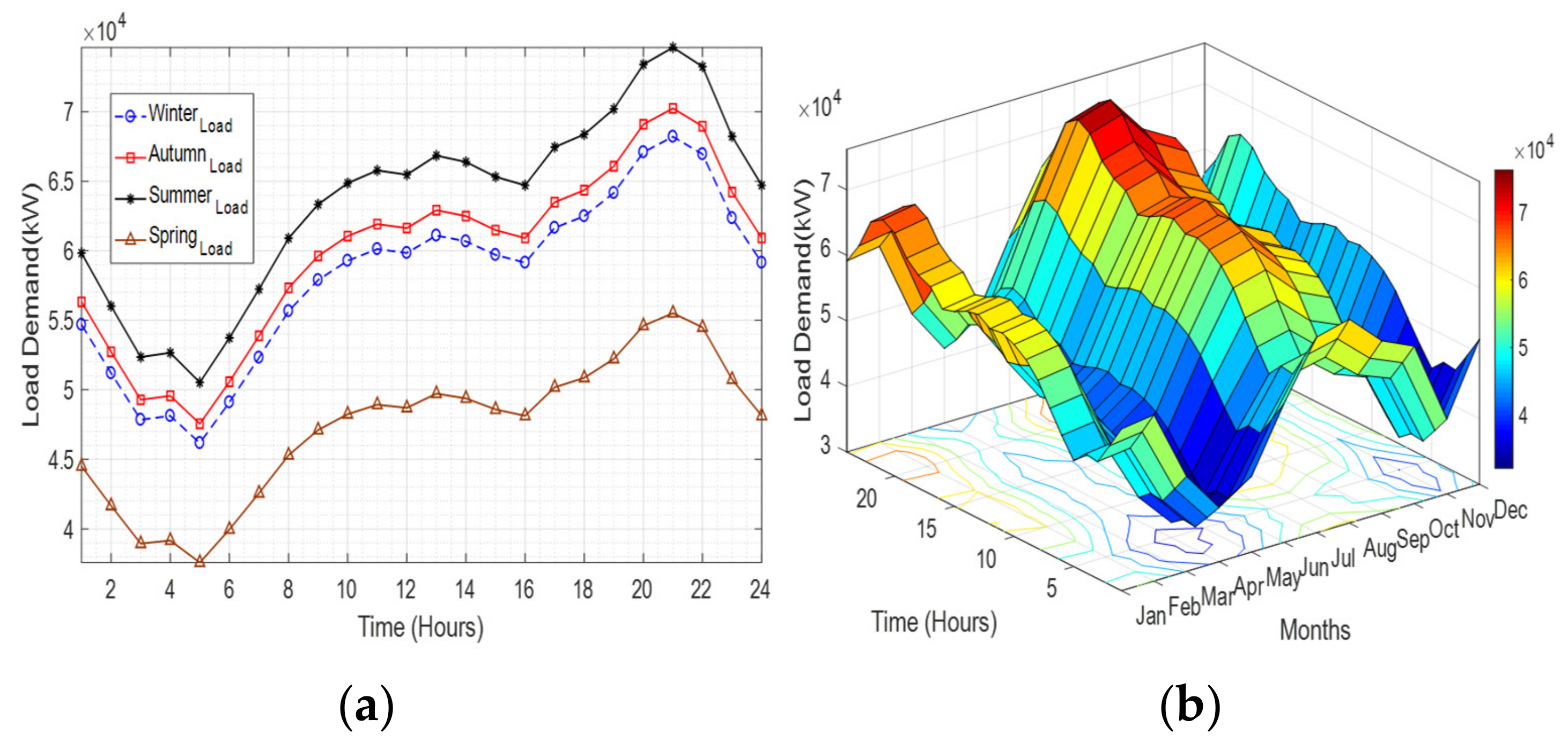

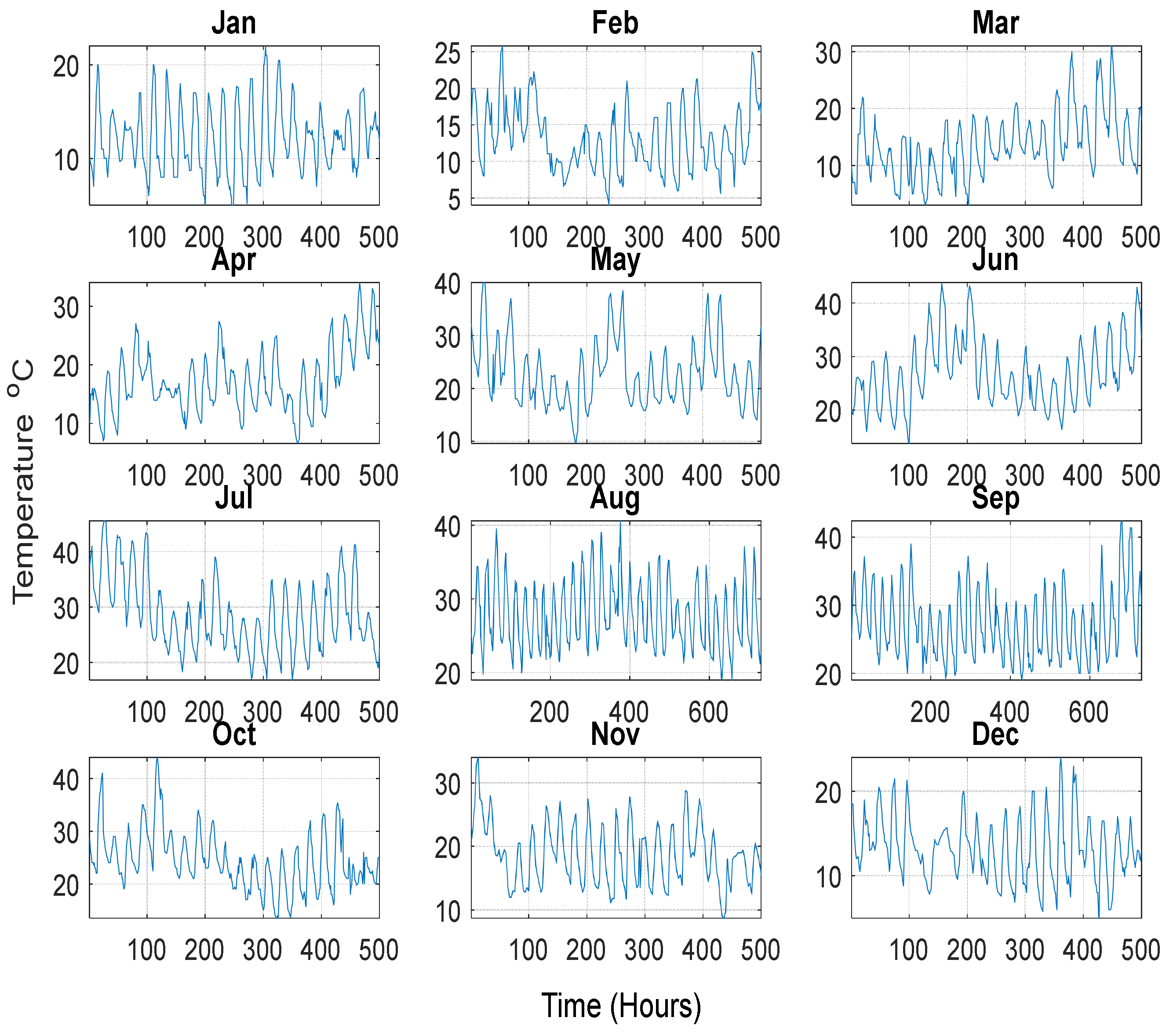
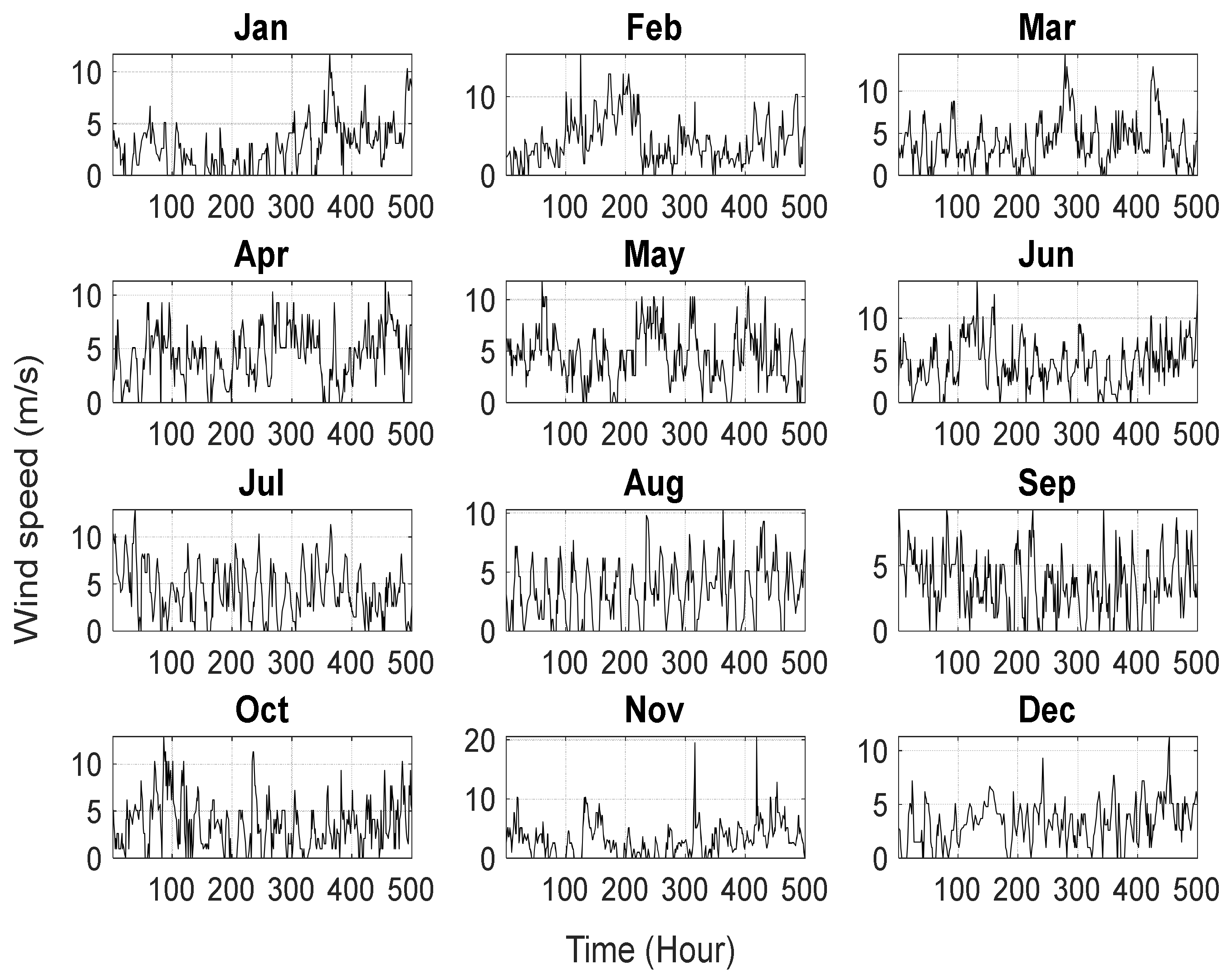
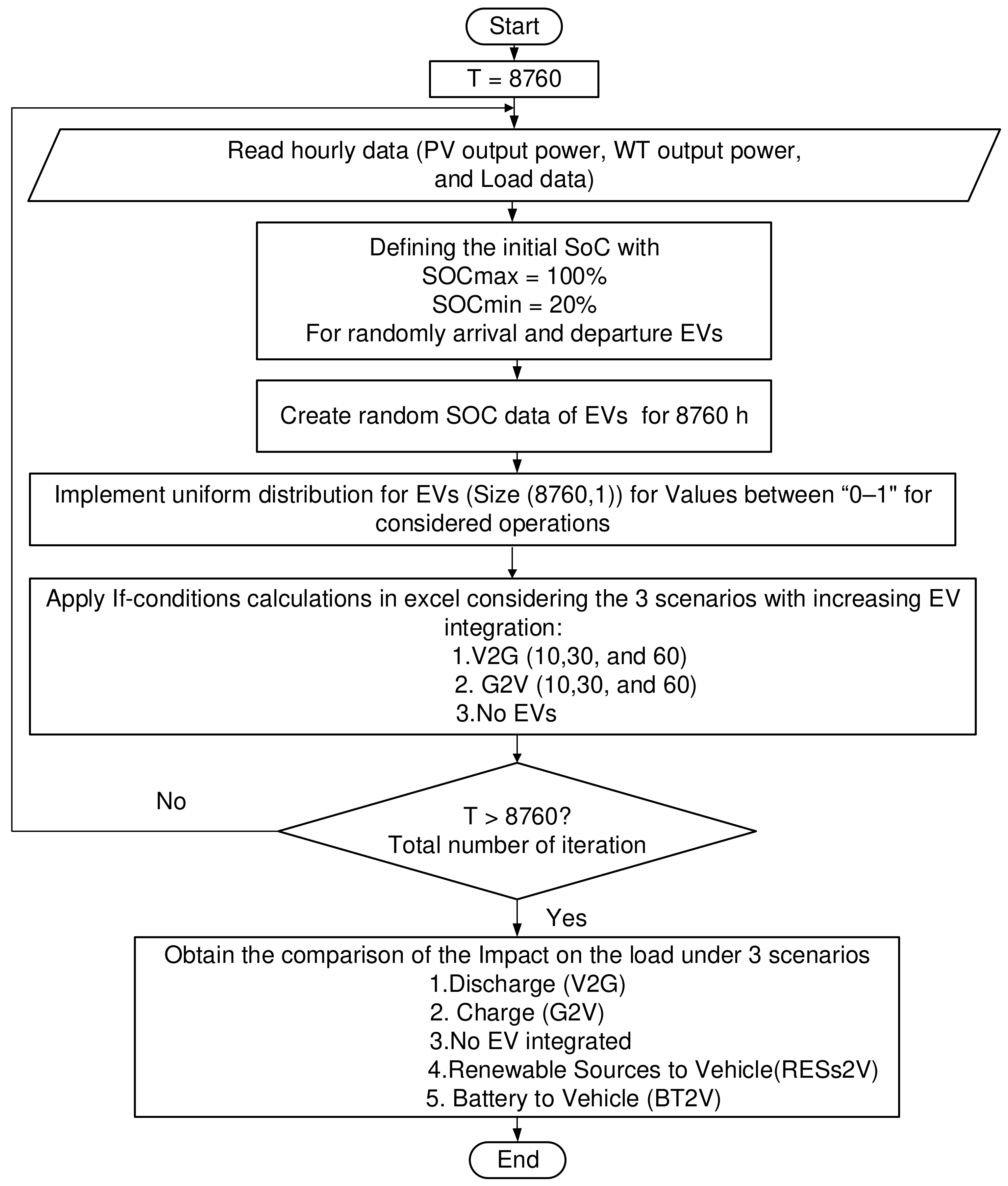
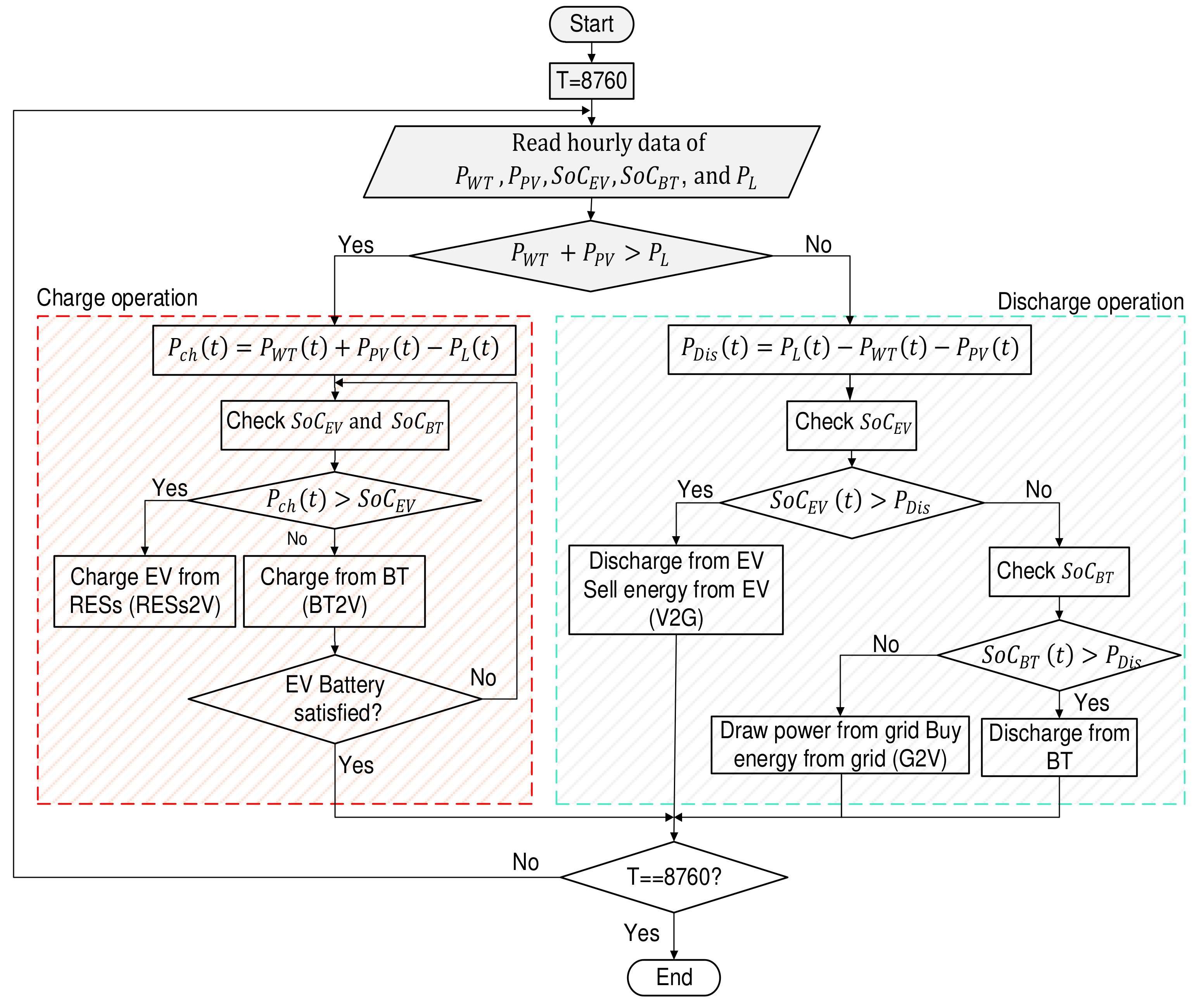

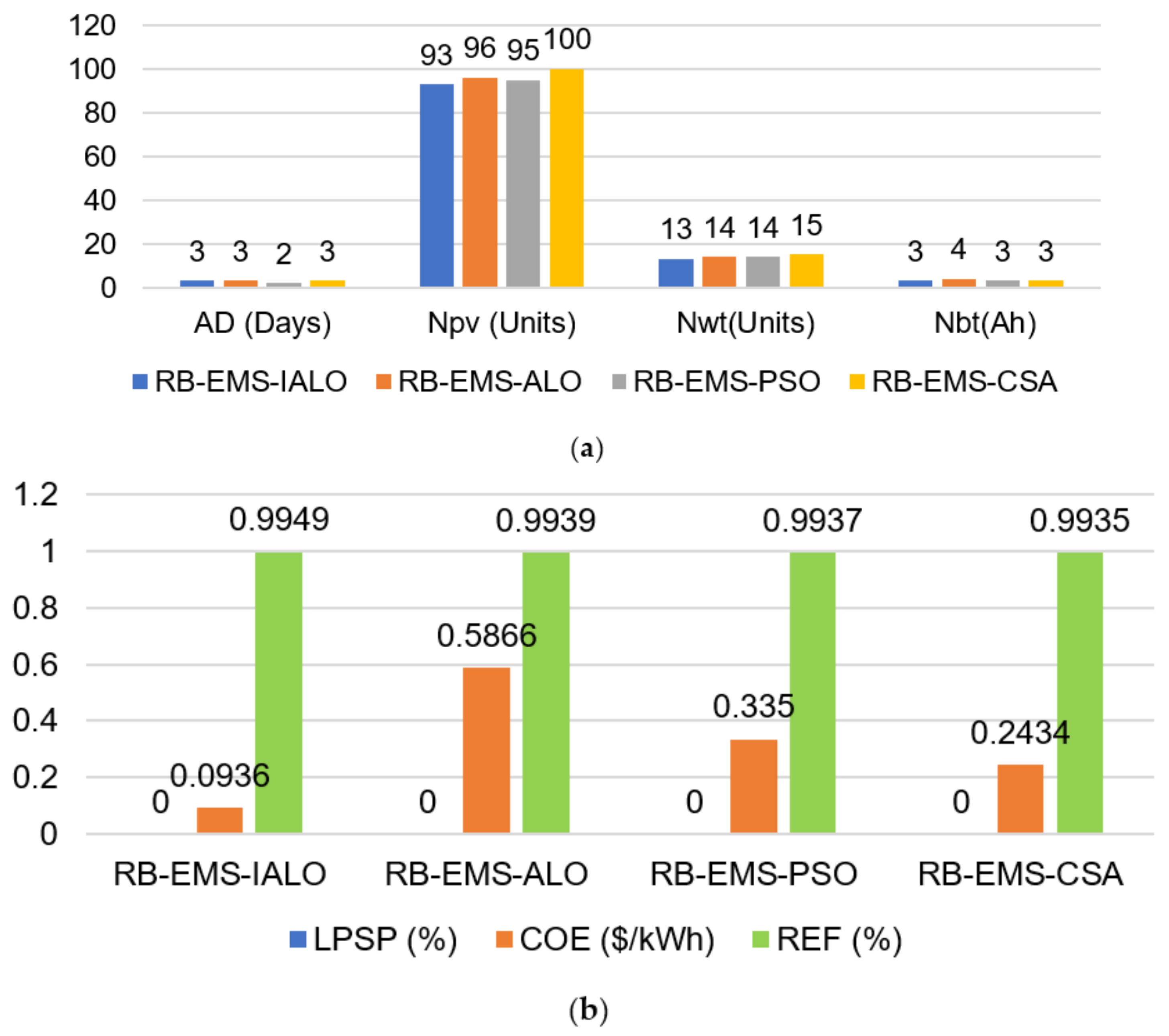
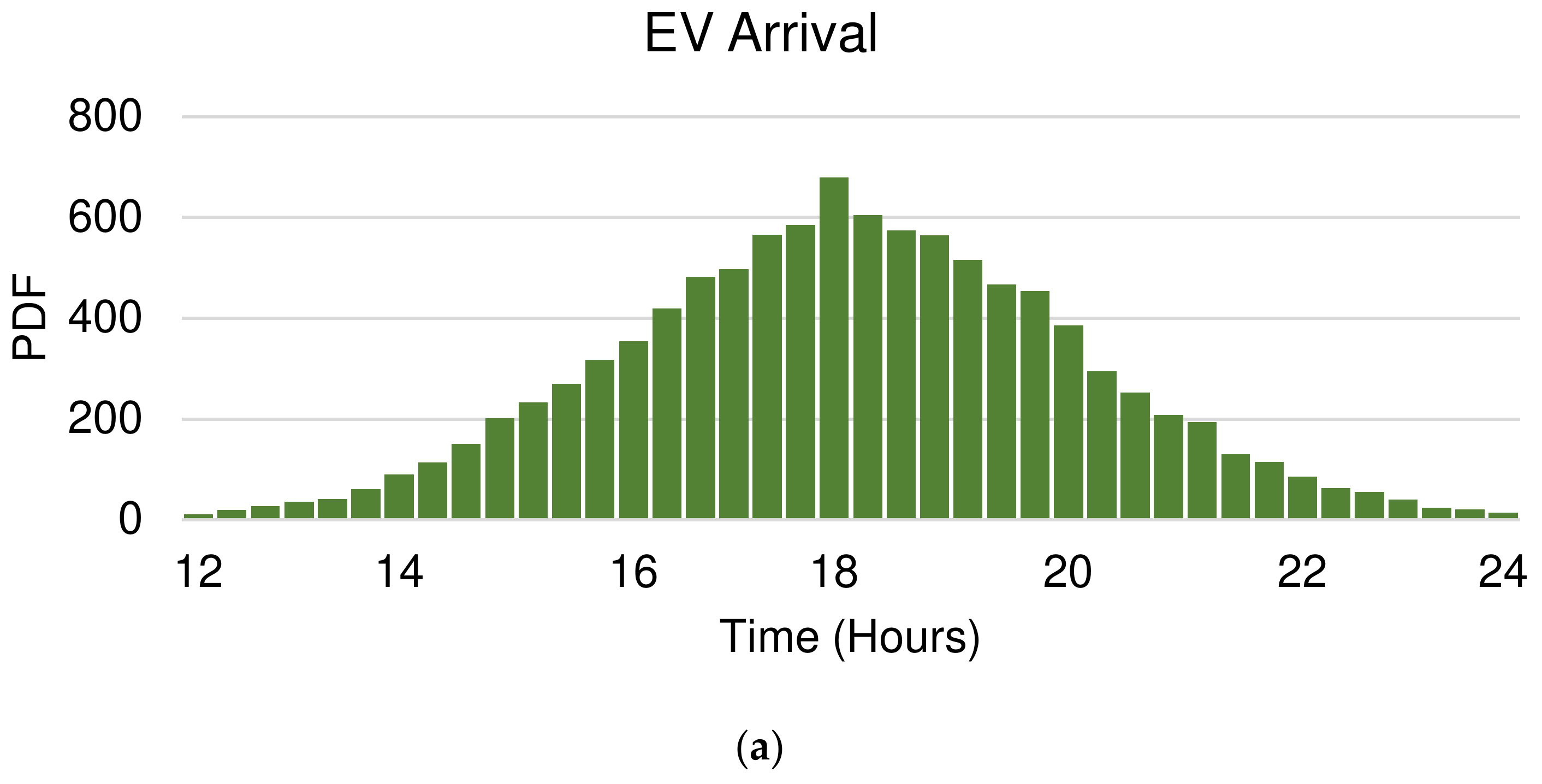

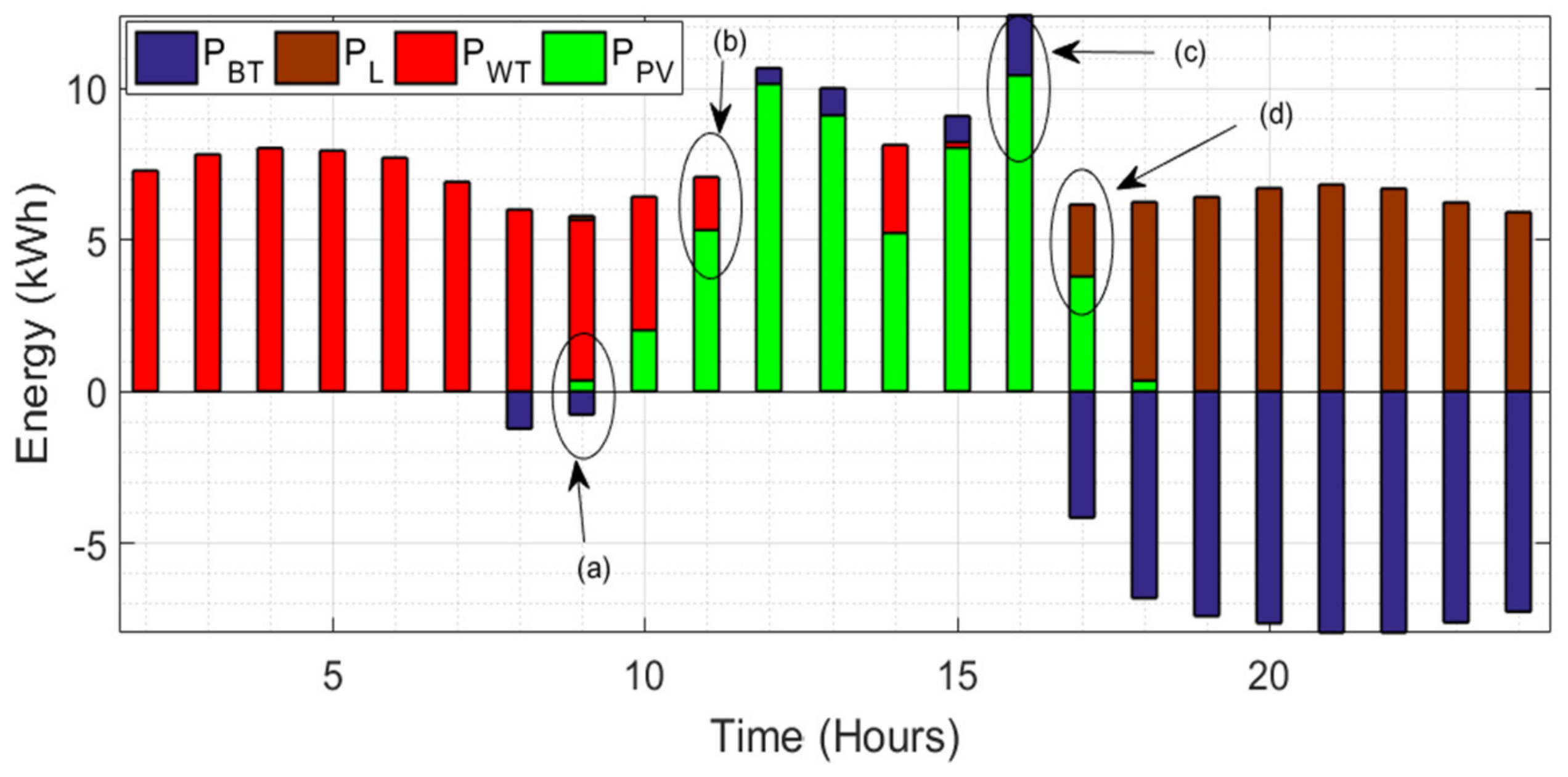




| Parameters | Specification | Value | Units |
|---|---|---|---|
| Photovoltaic [33] | Initial power at STC | 275 | W |
| Initial Cost | 2.15 | $/WP | |
| Lifetime | 25 | Years | |
| Maintenance cost | 20 | $/year | |
| Nominal operating cell temperature | 45 | °C | |
| Temperature coefficient | −3.7 × 10−3 | 1/°C | |
| Module efficiency | 16.9 | % | |
| Replacement cost | 0 | $/year | |
| Battery [34] | Lifetime | 2 | Year |
| Hourly self-discharge rate | 0.007 | %/hour | |
| Initial cost | 280 | $/kWh | |
| O&M Cost | 1 | $/% | |
| Rated capacity | 45.2 | kWh | |
| Maximum DOD | 70 | % | |
| Max SoC | 100 | % | |
| Min SoC | 30 | % | |
| Replacement cost | 280 | $/year | |
| Maintenance cost | 5 | $/year | |
| Converter [35] | Lifetime | 15 | Years |
| Efficiency | 92 | % | |
| Initial cost | 2500 | $ | |
| Economic parameters details [35] | Project lifetime | 25 | Years |
| Inflation rate | 5 | % | |
| Interest rate | 3 | % | |
| Wind Turbine [36] | Cut-in wind speed | 3 | m/s |
| Cut-out wind speed | 25 | m/s | |
| Rated power of wind turbine | 7.5 | kW | |
| Rated wind speed | 13 | m/s | |
| Replacement cost | 0 | $/unit | |
| Electric Vehicle [37,38] | Maximum SoC | 0.95 | % |
| Minimum SoC | 0.2 | % | |
| Lithium-ion battery | 250 | Wh/kg | |
| Electric Grid | Power importing price (sell) | 0.05 | $/kWh |
| Power exporting price (purchase) | 0.04 | $/kWh |
| Operations | If | Then |
|---|---|---|
| Mode 1 (RESs2V) | ||
| Mode 2 (BT2V) | ||
| Mode 3 (G2V) | ||
| Mode 4 (V2G) |
Disclaimer/Publisher’s Note: The statements, opinions and data contained in all publications are solely those of the individual author(s) and contributor(s) and not of MDPI and/or the editor(s). MDPI and/or the editor(s) disclaim responsibility for any injury to people or property resulting from any ideas, methods, instructions or products referred to in the content. |
© 2023 by the authors. Licensee MDPI, Basel, Switzerland. This article is an open access article distributed under the terms and conditions of the Creative Commons Attribution (CC BY) license (https://creativecommons.org/licenses/by/4.0/).
Share and Cite
Alsharif, A.; Tan, C.W.; Ayop, R.; Al Smin, A.; Ali Ahmed, A.; Kuwil, F.H.; Khaleel, M.M. Impact of Electric Vehicle on Residential Power Distribution Considering Energy Management Strategy and Stochastic Monte Carlo Algorithm. Energies 2023, 16, 1358. https://doi.org/10.3390/en16031358
Alsharif A, Tan CW, Ayop R, Al Smin A, Ali Ahmed A, Kuwil FH, Khaleel MM. Impact of Electric Vehicle on Residential Power Distribution Considering Energy Management Strategy and Stochastic Monte Carlo Algorithm. Energies. 2023; 16(3):1358. https://doi.org/10.3390/en16031358
Chicago/Turabian StyleAlsharif, Abdulgader, Chee Wei Tan, Razman Ayop, Ahmed Al Smin, Abdussalam Ali Ahmed, Farag Hamed Kuwil, and Mohamed Mohamed Khaleel. 2023. "Impact of Electric Vehicle on Residential Power Distribution Considering Energy Management Strategy and Stochastic Monte Carlo Algorithm" Energies 16, no. 3: 1358. https://doi.org/10.3390/en16031358
APA StyleAlsharif, A., Tan, C. W., Ayop, R., Al Smin, A., Ali Ahmed, A., Kuwil, F. H., & Khaleel, M. M. (2023). Impact of Electric Vehicle on Residential Power Distribution Considering Energy Management Strategy and Stochastic Monte Carlo Algorithm. Energies, 16(3), 1358. https://doi.org/10.3390/en16031358






